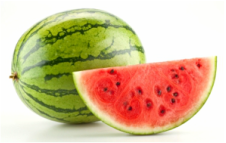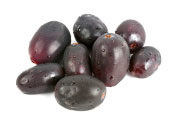
 Black-colored fruit of a tropical tree Syzygium cumini, also known as jambul, jambolan, jambolang, jamun, jaam/kalojaam, jamblang, jambolan, black plum, Damson plum, Duhat plum, Jambolan plum or Portuguese plum. Java plum is known to relieve stomach pain, flatulence (carminative), could prevent scurvy (anti-scorbutic) and is a diuretic. Ployphenolic compounds of this fruit might be effective against cancer, heart diseases, diabetes, asthma, arthritis, digestive issues and in increasing sexual activity.
Comments
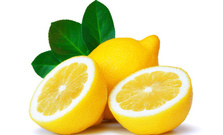 Yellow, oval citrus fruit with thick skin and fragrant, acidic juice. Its juice, pulp and peel, especially the zest, are used as foods. Lemons, like other citrus foods are very high in vitamins, especially vitamin C. Lemons are antiseptic, digestive aids, promote immunity and fight infection. The Ancient Egyptians believed that eating lemons and drinking lemon juice was an effective protection against a variety of poisons.  tropical fruit with yellowish-red flesh that is eaten ripe or used green for pickles or chutneys. It's been an important plant in Ayurvedic and indigenous medical systems for over 4000 years. It contains digestive enzymes (with α-amylase and α-glucosidase activities) and antioxidants (e.g. mangiferin), fiber and vitamins. Mango possesses antidiabetic, anti-oxidant, anti-viral, cardiotonic, hypotensive, anti-inflammatory properties. Various effects like antibacterial, anti fungal, anthelmintic, anti parasitic, anti tumor, anti HIV, antibone resorption, antispasmodic, antipyretic, antidiarrhoeal, antiallergic, immunomodulation, hypolipidemic, anti microbial, hepatoprotective, gastroprotective have also been studied. It helps with digestion, prevention of constipation, decreases risk of macular degeneration and colon cancer. It could also lower cholesterol levels, improve bone health and clear acne. 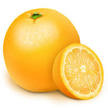 a round juicy citrus fruit with a sectioned, pulpy interior and a tough bright yellow or reddish rind. Sweet oranges are fruits of Citrus sinensis is the family Rutaceae, while bitter oranges (also called Seville, sour, bigarade or marmalade oranges) refer to Citrus aurantium. All oranges are hybrids between pomelo (Citrus maxima, about 25% of genes) and mandarin (Citrus reticulata, 75% of genes). Hybridization might have happened at least 2,300 years ago, or much earlier.  bottled or freshly squeezed juice of oranges, round juicy citrus fruits with a tough bright reddish-yellow rind. Many popular orange juice brands use a chemical process to create juice that tastes and smells like oranges, and 'Not from Concentrate' doesn't actually mean less processed. Orange juice is shown to boost alertness and concentration.  technically a berry, yellow-orange fruit from 1.5 to 9 cm (0.5 to 4 in) in diameter, that may be spherical, acorn-, or pumpkin-shaped, eaten fresh, dried, raw, or cooked. The ripe fruit have a high glucose content. There are astringent and non-astringent types of persimmon. Astringent persimmons (like heart-shaped Hachiya) contain very high levels of soluble tannins if eaten before completely softened. Persimmons contain high levels of dietary fiber, phenolic compounds, potassium, magnesium, calcium, iron and manganese, vitamin C and beta carotene, and compounds with possible anti-tumor properties betulinic acid and shibuol. Regular consumption might improve cardiovascular health and fat metabolism. The excessive absorption of tannic acid, however, can make the tongue become numb and induce gastric diseases. Crab and sweet potatoes combined with persimmons could trigger gastric issues too, possibly because proteins and tannins form insoluble complexes under some conditions. Persimmons can lower blood pressure, and are not recommended to be eaten up to 2 weeks before and after surgery. 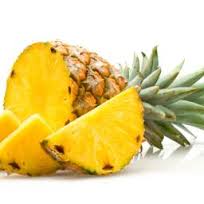 A large juicy tropical fruit consisting of aromatic edible yellow flesh surrounded by a tough segmented skin and topped with a tuft of stiff leaves. It is widely used in everything from meat dishes to desserts & cocktails. While it is sweet, it is also known for its high acid content and helps aid digestion. In the scientific name of pineapple Ananas comosus, ananas, the original name of the fruit, comes from the Tupi word nanas, meaning "excellent fruit"  oval fleshy fruit with smooth skin that is reddish, purple, blue, light green or yellow when ripe. Its pulp is juicy, succulent and could be creamy yellow, crimson, light-blue or light-green in color. Botanical "relatives" of plums include peaches, nectarine, almonds, and damson, all featuring a hard pit. Plums are low in calories (46 calories per 100 g or 1-2 plums) and are high in fiber sorbitol and isatin that help to aleviate constipation. They are a good source of antioxidants and vitamins such as Vitamin A/beta carotene (especially high in Mirabelle plums), and minerals such as potassium. 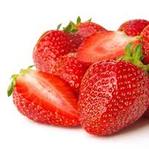 a sweet soft red fruit of Fragaria plant with a seed-studded surface, widely appreciated for its characteristic aroma, bright red color, juicy texture, and sweetness. Aroma chemicals include benzyl acetate, benzaldehyde, 2-heptenol, ethyl hexanoate, limonene, 2-octenal, linalool and ethyl cinnemate. Methyl and ethyl butanoate, methyl hexanoate, hexyl- and E-2-hexenyl acetates also largely constribute to the strawberry aroma. Ethyl methylphenylglycidate is commonly known as "strawberry aldehyde"and is used in artificial fruit flavors. |
Categories
All
|
